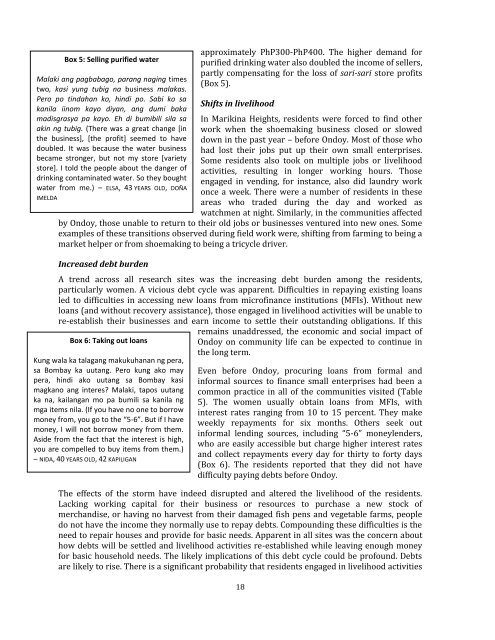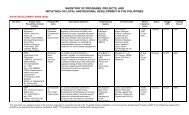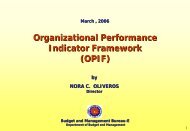rapid assessment of the social impacts of - Philippines Development ...
rapid assessment of the social impacts of - Philippines Development ...
rapid assessment of the social impacts of - Philippines Development ...
Create successful ePaper yourself
Turn your PDF publications into a flip-book with our unique Google optimized e-Paper software.
Box 5: Selling purified water<br />
Malaki ang pagbabago, parang naging times<br />
two, kasi yung tubig na business malakas.<br />
Pero po tindahan ko, hindi po. Sabi ko sa<br />
kanila iinom kayo diyan, ang dumi baka<br />
madisgrasya pa kayo. Eh di bumibili sila sa<br />
akin ng tubig. (There was a great change [in<br />
<strong>the</strong> business], [<strong>the</strong> pr<strong>of</strong>it] seemed to have<br />
doubled. It was because <strong>the</strong> water business<br />
became stronger, but not my store [variety<br />
store]. I told <strong>the</strong> people about <strong>the</strong> danger <strong>of</strong><br />
drinking contaminated water. So <strong>the</strong>y bought<br />
water from me.) – ELSA, 43 YEARS OLD, DOÑA<br />
IMELDA<br />
approximately PhP300-PhP400. The higher demand for<br />
purified drinking water also doubled <strong>the</strong> income <strong>of</strong> sellers,<br />
partly compensating for <strong>the</strong> loss <strong>of</strong> sari-sari store pr<strong>of</strong>its<br />
(Box 5).<br />
Shifts in livelihood<br />
In Marikina Heights, residents were forced to find o<strong>the</strong>r<br />
work when <strong>the</strong> shoemaking business closed or slowed<br />
down in <strong>the</strong> past year – before Ondoy. Most <strong>of</strong> those who<br />
had lost <strong>the</strong>ir jobs put up <strong>the</strong>ir own small enterprises.<br />
Some residents also took on multiple jobs or livelihood<br />
activities, resulting in longer working hours. Those<br />
engaged in vending, for instance, also did laundry work<br />
once a week. There were a number <strong>of</strong> residents in <strong>the</strong>se<br />
areas who traded during <strong>the</strong> day and worked as<br />
watchmen at night. Similarly, in <strong>the</strong> communities affected<br />
by Ondoy, those unable to return to <strong>the</strong>ir old jobs or businesses ventured into new ones. Some<br />
examples <strong>of</strong> <strong>the</strong>se transitions observed during field work were, shifting from farming to being a<br />
market helper or from shoemaking to being a tricycle driver.<br />
Increased debt burden<br />
A trend across all research sites was <strong>the</strong> increasing debt burden among <strong>the</strong> residents,<br />
particularly women. A vicious debt cycle was apparent. Difficulties in repaying existing loans<br />
led to difficulties in accessing new loans from micr<strong>of</strong>inance institutions (MFIs). Without new<br />
loans (and without recovery assistance), those engaged in livelihood activities will be unable to<br />
re-establish <strong>the</strong>ir businesses and earn income to settle <strong>the</strong>ir outstanding obligations. If this<br />
Box 6: Taking out loans<br />
Kung wala ka talagang makukuhanan ng pera,<br />
sa Bombay ka uutang. Pero kung ako may<br />
pera, hindi ako uutang sa Bombay kasi<br />
magkano ang interes? Malaki, tapos uutang<br />
ka na, kailangan mo pa bumili sa kanila ng<br />
mga items nila. (If you have no one to borrow<br />
money from, you go to <strong>the</strong> “5-6”. But if I have<br />
money, I will not borrow money from <strong>the</strong>m.<br />
Aside from <strong>the</strong> fact that <strong>the</strong> interest is high,<br />
you are compelled to buy items from <strong>the</strong>m.)<br />
– NIDA, 40 YEARS OLD, 42 KAPILIGAN<br />
remains unaddressed, <strong>the</strong> economic and <strong>social</strong> impact <strong>of</strong><br />
Ondoy on community life can be expected to continue in<br />
<strong>the</strong> long term.<br />
Even before Ondoy, procuring loans from formal and<br />
informal sources to finance small enterprises had been a<br />
common practice in all <strong>of</strong> <strong>the</strong> communities visited (Table<br />
5). The women usually obtain loans from MFIs, with<br />
interest rates ranging from 10 to 15 percent. They make<br />
weekly repayments for six months. O<strong>the</strong>rs seek out<br />
informal lending sources, including “5-6” moneylenders,<br />
who are easily accessible but charge higher interest rates<br />
and collect repayments every day for thirty to forty days<br />
(Box 6). The residents reported that <strong>the</strong>y did not have<br />
difficulty paying debts before Ondoy.<br />
The effects <strong>of</strong> <strong>the</strong> storm have indeed disrupted and altered <strong>the</strong> livelihood <strong>of</strong> <strong>the</strong> residents.<br />
Lacking working capital for <strong>the</strong>ir business or resources to purchase a new stock <strong>of</strong><br />
merchandise, or having no harvest from <strong>the</strong>ir damaged fish pens and vegetable farms, people<br />
do not have <strong>the</strong> income <strong>the</strong>y normally use to repay debts. Compounding <strong>the</strong>se difficulties is <strong>the</strong><br />
need to repair houses and provide for basic needs. Apparent in all sites was <strong>the</strong> concern about<br />
how debts will be settled and livelihood activities re-established while leaving enough money<br />
for basic household needs. The likely implications <strong>of</strong> this debt cycle could be pr<strong>of</strong>ound. Debts<br />
are likely to rise. There is a significant probability that residents engaged in livelihood activities<br />
18




